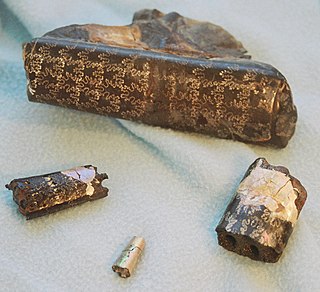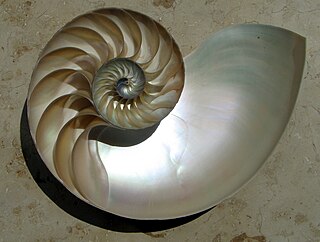
Nautiloids are a group of marine cephalopods (Mollusca) which originated in the Late Cambrian and are represented today by the living Nautilus and Allonautilus. Fossil nautiloids are diverse and species rich, with over 2,500 recorded species. They flourished during the early Paleozoic era, when they constituted the main predatory animals. Early in their evolution, nautiloids developed an extraordinary diversity of shell shapes, including coiled morphologies and giant straight-shelled forms (orthocones). No orthoconic and only a handful of coiled species, the nautiluses, survive to the present day.

Baculites is an extinct genus of heteromorph ammonite cephalopods with almost straight shells. The genus, which lived worldwide throughout most of the Late Cretaceous, and which briefly survived the K-Pg mass extinction event, was named by Lamarck in 1799.

Septa are thin walls or partitions between the internal chambers (camerae) of the shell of a cephalopod, namely nautiloids or ammonoids.

The Bactritida are a small order of more or less straight-shelled (orthoconic) cephalopods that first appeared during the Emsian stage of the Devonian period with questionable origins in the Pragian stage before 409 million years ago, and persisted until the Carnian pluvial event in the upper middle Carnian stage of the Triassic period. They are considered ancestors of the ammonoids, as well as of the coleoids.
Discosorida are an order of cephalopods that lived from the beginning of the Middle Ordovician, through the Silurian, and into the Devonian. Discosorids are unique in the structure and formation of the siphuncle, the tube that runs through and connects the camerae (chambers) in cephalopods, which unlike those in other orders is zoned longitudinally along the segments rather than laterally. Siphuncle structure indicated that the Discosorida evolved directly from the Plectronoceratida rather than through the more developed Ellesmerocerida, as did the other orders. Finally and most diagnostic, discosorids developed a reinforcing, grommet-like structure in the septal opening of the siphuncle known as the bullette, formed by a thickening of the connecting ring as it draped around the folded back septal neck.

The Oncocerida comprise a diverse group of generally small nautiloid cephalopods known from the Middle Ordovician to the Mississippian, in which the connecting rings are thin and siphuncle segments are variably expanded. At present the order consists of some 16 families, a few of which, such as the Oncoceratidae, Brevicoceratidae, and Acleistoceratidae contain a fair number of genera each while others like the Trimeroceratidae and Archiacoceratidae are represented by only two or three.
Jovellania is a genus of extinct prehistoric nautiloids from the order Oncocerida known from the Lower Devonian of Europe. Nautiloids form a broad group of shelled cephalopods that were once diverse and numerous but are now represented by only a handful of species in two genera.
Brevicoceras is an extinct nautiloid genus from the order Oncocerida with wide distribution in the Middle Devonian in Eastern North America, Russia and Morocco. Nautiloids form a broad group of shelled cephalopods that were once diverse and numerous but are now represented by only a handful of species in two genera.
Zittelloceras is an extinct genus of nautiloids from the order Oncocerida which are among a large group of once diverse and numerous shelled cephalopods, now represented by only a handful of species.
The Tripteroceratidae is a family of depressed, straight to slightly curved nautiloid cephalopods from the middle and upper Ordovician with generally flattened venters and empty siphuncles with straight to inflated segments included in the Oncocerida.
Oonoceras is an extinct genus of fossil cephalopods included in the nautiloid order Oncocerida and the family Oncoceratidae from the Middle Ordovician to Middle Silurian of North America and Europe, arbitrarily included in the Slender Oncoceratidae.
The Valcouroceratidae is a family within the Oncocerida, nautiloid cephalopods from the middle and upper Ordovician, established by Rousseau Flower in 1945.
Blakeoceras is a nautiloid cephalopod from the Oncocerida family Nothoceratidae with a curved shell that lived in shallow seas from the Silurian to the Middle Devonian in what has become Europe.
Perimecoceras is a genus of nothoceratids, nautilitoids in the order Oncocerida, with a slowly expanding, compressed, cyrtoconic shell, known from the Upper Silurian of central Europe.
Fayettoceras is a genus in the nautiloid family Valcouroceratidae, part of the order Oncocerida, Fayettoceras has a shell which is a depressed cyrtocone with a ventral cyrtochoanitic siphuncle of elongated ovoid segments strongly contracted at the septal necks. The internal structure is unknown.
Augustoceras is a genus of nautiloid cephalopods included in the order Oncocerida and family Valcouroceratidae. It is known form the Middle and Upper Ordovician of Kentucky and Ohio in the US.
Valcouroceras is the type genus for the Valcouroceratidae, a family in the nautiloid order Oncocerida named by Rousseau Flower, 1943, named for Valcour Island in Lake Champlain, between New York state and Vermont, where it was first discovered.
Danoceras is an essentially straight shelled oncocerid named by Troedsson in 1926, and included in the Diestoceratidae. It has been found in the upper, and possibly middle, Ordovician of Europe, (Estonia), Greenland, and Russia,. Named species include Danoceras ravni, type, D. inutile, D. scandinavicum, and D. skalbergensis.
Aletoceras is a genus of Oncocerida nautiloids from the middle Devonian of North America included in the family Brevicoceratidae.
Codoceras is a genus of nautiloids belonging to the Polyelasmoceratidae, an Oncocerida family.




